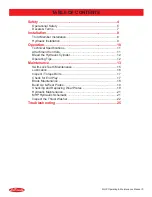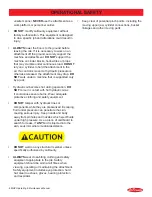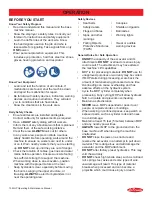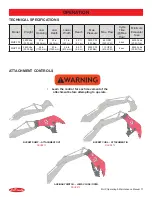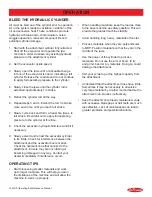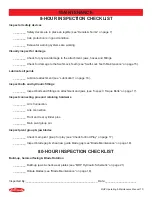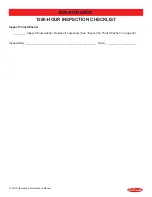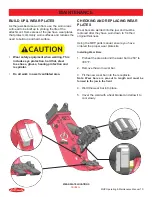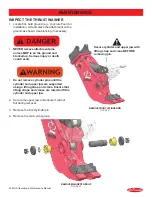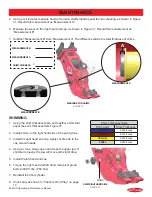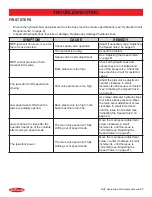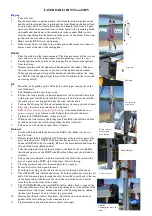
12 MHP Operating & Maintenance Manual
OPERATION
Air must be bled out of the cylinder prior to operation.
Air in the system leads to cavitation, oxidation of the
oil and excessive heat. These conditions promote
hydraulic oil break-down, contamination, noise,
sluggish operation, reduced component life and
potential cylinder damage.
1. Start with the attachment cylinder fully retracted.
Shut off the excavator and operate the jaw
controls in order to relieve any existing hydraulic
pressure to the attachment cylinder.
2.
Set the excavator at idle speed.
3. Slowly open the jaws until a noticeable change
in tone of the excavator is heard, indicating a full
cylinder. Release the controls and do not continue
to apply full operating pressure to the cylinder.
4. Slowly close the jaws until the cylinder rod is
extended approximately 1/4 stroke.
5. Retract the cylinder rod all the way.
6.
Repeat steps 3 and 4. Extend the rod 1/4 stroke
more each time, until you reach full stroke.
7.
Slowly cycle back and forth, at least five times, to
full stroke. Be careful not to apply full operating
pressure to the cylinder at this time.
8.
Check the excavator hydraulic fluid level and fill if
necessary.
9.
Slowly extend and retract the excavator cylinder
to it’s limits. Check for interference between the
attachment and the excavator boom or stick.
Check the hydraulic lines that connect to the
attachment . Ensure they are not rubbing or
becoming damaged in any way. Contact your
dealer immediately if interference occurs.
OPERATING TIPS
•
Start processing smaller materials and work
up to larger materials. This will help you learn
the limitations of the machine and will allow the
machine to warm up properly.
•
When handling materials, keep the load as close
to the base machine as safely possible. This will
provide the greatest machine stability.
• Avoid handling long, heavy materials off center.
• Process materials when they are perpendicular
to MHP. Position materials so that they are in the
middle of the jaws.
• Use the power of the cylinder to process
materials. Do not use the arm or boom to try
and grind, bend or pry materials. Doing so could
damage the attachment.
• Sort your scrap to get the highest capacity from
the attachment.
• Understand that the attachment does have limits.
Sometimes it may be necessary to downsize
very large material by another method before the
attachment can process it effectively.
• Keep the attachment properly maintained. Jaws
with excessive blade gaps or dull teeth are much
less effective. Lack of maintenance can lead to
greater problems and potential downtime.
BLEED THE HYDRAULIC CYLINDER



